Arts in the News
Maxwell Seelig ’22 Stars in Boston Production of Little Women
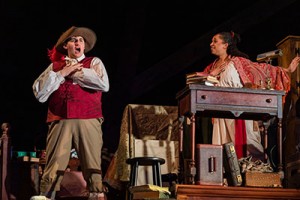 When Maxwell Seelig ’22 auditioned for his role of Theodore “Laurie” Laurence in the Wheelock Family Theatre’s production of Little Women: The Broadway Musical, he was worried that his self-described clumsiness would make him a bad fit. After all, actors like Christian Bale and Timothée Chalamet have portrayed Laurie as a suave and worldly member of nineteenth-century society.
When Maxwell Seelig ’22 auditioned for his role of Theodore “Laurie” Laurence in the Wheelock Family Theatre’s production of Little Women: The Broadway Musical, he was worried that his self-described clumsiness would make him a bad fit. After all, actors like Christian Bale and Timothée Chalamet have portrayed Laurie as a suave and worldly member of nineteenth-century society.
“I was one of the youngest people there, and there were actors from the Boston Conservatory auditioning, there were professionals from New York auditioning, and so I thought ‘This has been fun. I will not be getting this part,’” Max says. “But they told me they were looking specifically for a kind of quirky, awkward teenage energy.”
Based on the novel Little Women by Louisa May Alcott, the musical chronicles the lives of the March sisters—Jo, Meg, Beth, and Amy—and Laurie as they come of age in Concord, Massachusetts, during the Civil War.
Boyish charm, cracking through the real messiness of adolescence, is what director Nick Vargas wanted to find in Laurie, who ages from 16 to 21 during the course of the show, Max says. Laurie stumbles over his own words, and Max has to embody his insecurities. Every character has “genuinely human flaws,” he explains.
Max has a grueling schedule: Balancing eight shows a week and the rigors of a Milton education, he has had to manage his time with precision. Since Laurie is not in every scene, Max has squeezed in his school work during breaks in the action—he finished a paper on Antigone backstage one evening.
“When I have more stuff on my plate, my work either stays at the same level or even improves a little,” he says. “Somehow the little extra pressure seems to help me.”
Acting has been a part of Max’s life since he was at the Temple Israel of Boston’s preschool. At the age of 5, he got hooked on performing in the school’s version of Little Red Hen. He has performed in several Milton productions, including Class IV Follies and Rosencrantz & Guildenstern Are Dead.
For some years during his childhood, Max had a medical condition that affected his mood and emotions. Performing was a refuge. “I didn’t really understand what was happening around me,” he says. “Acting was an opportunity to be someone else for a moment. There’s something incredibly cathartic about that.”
The diverse, female-led cast has offered Max some powerful role models, he says. And their differences have helped shape the story.
“We have so many different voices coming into this production, so many different backgrounds,” he says. “It’s given a lot of new perspectives on questions ‘What is family?’ and ‘What is home?’ that haven’t always been included with this story before.”
The Wheelock Family Theatre is located on the campus of Boston University. Little Women runs through Sunday, February 23.
Wit And Wordplay Take The Stage in Rosencrantz and Guildenstern Are Dead
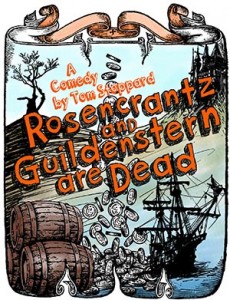 Two minor characters from one of the most well-known tragedies in theater history take the comedy spotlight in this year’s fall play, Rosencrantz and Guildenstern are Dead. The 1966 Tom Stoppard play follows the story of the title characters, messengers from Shakespeare’s Hamlet, who are bewildered by the events around them.
Two minor characters from one of the most well-known tragedies in theater history take the comedy spotlight in this year’s fall play, Rosencrantz and Guildenstern are Dead. The 1966 Tom Stoppard play follows the story of the title characters, messengers from Shakespeare’s Hamlet, who are bewildered by the events around them.
“The entire play is from their point of view, and tries to explain who they are, but they don’t even know,” says performing arts faculty member Darlene Anastas, who is directing the show. “They don’t get their names straight. They know they’ve been sent for, but they don’t know why. You ponder life and death with the characters, but it’s really very funny.”
Phoebe Mugford ’21 and Ben Simpson ’21 star as Rosencrantz and Guildenstern, respectively. Caitlin Waugh ’20 composed some original music for the show.
The main characters are “quite strange as individuals and as friends, so it has been fun and exciting to develop the roles,” says Phoebe. Stoppard’s wordplay has been a challenge to master, but the tight-knit cast makes for fun and entertaining rehearsals.
“The play focuses on what death means, in a comedic and light way,” Phoebe says. “It shows that the weight of death does not come from the death itself but from the disappearance of a person from the world. It’s made me think about death differently.”
The original Stoppard play pays tribute to Samuel Beckett’s Waiting for Godot in Rosencrantz and Guildenstern. The central characters have a mission, but the show is about what happens to them along the way. The Milton production references Beckett in its set design and stage directions.
The fall play is always a logistical challenge, as little time separates the play and the Class IV Follies just a few weeks before. The choice of Rosencrantz and Guildenstern made sense, Dar says, because the play can have any setting, and it has been popular in recent years. In 2017, the show saw a revival on Broadway for its 50th anniversary and this month, Boston’s Huntington Theatre finished its month-long run.
“It’s a lot of fun,” Dar says. “Finding the comic elements to it and letting the actors develop their understanding of timing. It’s an incredibly witty play.”
Rosencrantz and Guildenstern are Dead opens Thursday, November 14 at 7:30 p.m. in King Theatre. It will run Friday, November 15, at 7:30 p.m. and Saturday, November 16 at 7 p.m. The show is open to the public; tickets may be reserved online.
“Creatures Great and Small” Outside the AMC
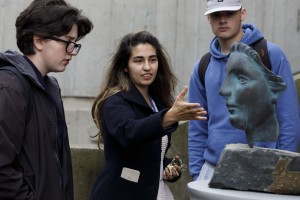 Two birds in flight, a swimming shark and a fanged fish are just a few of the sculptures that make up the “Creatures Great and Small” exhibit outside of the Art and Media Center (AMC). Each of the eight pieces is done by a different artist in materials such as bronze, granite, steel and resin. Pamela Tarbell of PR Tarbell Fine Art curated the exhibit, which is on display throughout this school year.
Two birds in flight, a swimming shark and a fanged fish are just a few of the sculptures that make up the “Creatures Great and Small” exhibit outside of the Art and Media Center (AMC). Each of the eight pieces is done by a different artist in materials such as bronze, granite, steel and resin. Pamela Tarbell of PR Tarbell Fine Art curated the exhibit, which is on display throughout this school year.
One of the pieces, “The Understudy,” by local artist Bob Shanahan, is housed inside the AMC. The sculpture, built out of natural materials such as bark and twigs, depicts a Diatryma, a dinosaur that roamed New England millions of years ago.
The other pieces line up in front of the AMC. Morris Norvin’s “Piscator II” is the largest —steel, painted gray and bent into the shape of swimming shark. The smallest is the sleek “Epoxy Cheetah” by Wendy Klemperer. New visual art faculty member and Netso Gallery director Shirin Adhami says a favorite of the younger students on campus is “Toothed Fish,” composed of granite and quartz by artist Thomas Berger.
Shirin’s Art History class discussed the pieces and she said many students are really responding to the exhibit’s “creatures” theme. In past years, outdoor installations focused on abstract work, so visual arts department chair Ian Torney said he asked the curator to think of a figurative theme, and from that came the idea of finding work that represented creatures.
The installation took place at the start of this school year, when all the artists brought their work on same day. Some pieces required some tricky lifting and heavy bases to anchor the pieces. Milton’s facilities team helped with the installation. One of the artists, Beverly Benson Seamons, Class of 1946, passed away in 2012, so her son did the installation of her “Osprey,” a bronze sculpture.
“School Girls; Or, The African Mean Girls Play” is This Fall’s 1212 Play
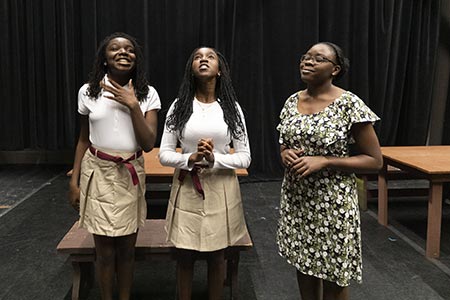 This fall’s 1212 play, School Girls; Or, The African Mean Girls Play, is a comedy that tackles issues of colorism, colonialism, beauty standards, and the social hierarchy among teenage girls.
This fall’s 1212 play, School Girls; Or, The African Mean Girls Play, is a comedy that tackles issues of colorism, colonialism, beauty standards, and the social hierarchy among teenage girls.
“Our play immerses the audience into the world of black girls, something that never happens,” says Nyla Sams ’20. “It also tackles societal problems that are, for the most part, ignored by everyone other than the group they affect. It is so exciting to bring this conversation to Milton, and on top of all that, it’s a fun play.”
Nyla plays Paulina, the “queen bee” of the exclusive Aburi Girls Boarding School in Ghana. Paulina’s dominance among her peers starts to crumble upon the arrival of Ericka—played by Katie Cabrera ’21—who transfers to the school from America during senior year. Ericka receives attention for her lighter skin, and the story highlights the imbalance and unfairness of beauty standards that often center white, Western features—even among people of color. The play, written by Jocelyn Bioh, takes a comic approach to the differences and similarities faced by girls around the world.
The characters are complex and multifaceted, says Katie, giving them depth and individuality. Audience members who have struggled to fit in anywhere will relate to the story, she adds.
“This show’s power comes primarily from the fact that it allows women of color to be seen as simply people, rather than victims,” she says. “It diverts from the typical, monolithic depiction and single story of Africa and African girls in particular. This show elevates the voices of girls who are often portrayed from a single perspective.”
Performing arts faculty member Patrice Jean-Baptiste is directing School Girls. The cast is small—just eight girls—but Patrice has found tasks for students who didn’t get parts, including assistant-directing and costuming. The 1212 play—named for the room in Warren Hall where the bare-bones, small production got its start—has a spare set design, but Patrice has sought out costumes that would look authentic in a Ghanaian school.
“The best parts have been where we’re not acting, where we’re not working, and the cast is just talking about some aspect of the play, and they’re really digging into questions like ‘What is it like to deal with this?’ ‘What makes someone beautiful?’ ‘Who’s got the perfect hair and who doesn’t?’” Patrice says.
Cast member Mia Adriko ’21 is new to performing. Mia, who is from Uganda, says, “The most challenging thing so far has been trying to find a common ground between my African identity and my character’s African identity. The most rewarding thing has been what I’ve gained by stepping entirely out of my comfort zone.” Working on the show has shown Mia the power of media images to “trickle down to affect young people in even the most unexpected places.”
School Girls runs from Thursday, October 31, to Saturday, November 2, in the Studio Theatre of the Kellner Performing Arts Center. Thursday and Friday shows begin at 7:30 p.m. and Saturday’s performance begins at 7 p.m.
“Class IV Follies” Explores the Masks We Wear
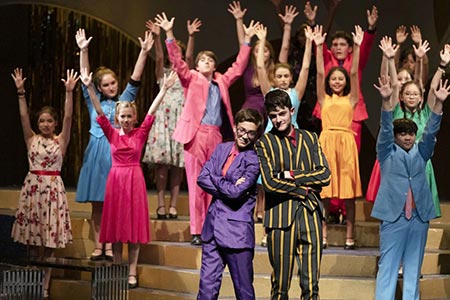 This year’s Class IV Follies, a revue highlighting the performing arts talents of the Class of 2023, follows the theme of masks, director and performing arts faculty member Eleza Kort says.
This year’s Class IV Follies, a revue highlighting the performing arts talents of the Class of 2023, follows the theme of masks, director and performing arts faculty member Eleza Kort says.
The production, which opens on Thursday night of Parents’ Weekend, features pieces related to the masks people wear and the six universal facial expressions: happiness, sadness, fear, disgust, anger, and surprise.
The performing arts department shifted its fall production schedule this year so a limited run of the Class IV Follies is scheduled for Parents’ Weekend. The show runs Thursday, October 24, and Friday, October 25, with both performances at 7:30 p.m. in King Theatre.
“The Class IV Follies is a new tradition, where we build a cabaret-style show around the kids that we have,” Eleza says. “The idea for the theme is that our masks are the emotions we wear on our face, and we have songs and scenes that represent those ideas. We picked this theme because we wanted to work with relationships and personalities.”
Nineteen members of Class IV are performing in the show, showing their talents in everything from the stand-up bass to sketch comedy. Performances include a choral version of Cyndi Lauper’s “True Colors,” “Revolting Children” from Matilda the Musical, and “Sit Down, You’re Rocking the Boat” from Guys and Dolls.
“Putting on a show is an incredibly bonding experience, so they get to know other kids in their class, and they each have their own moments to shine, which I think is what’s special about the Follies, as opposed to doing a play,” Eleza says. “This is also an exciting way to introduce them to a wide range of pieces from different shows that they may have never known before.”
